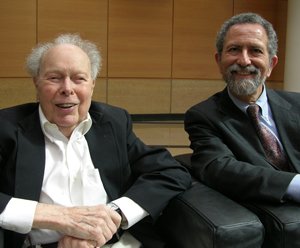 Whether or not you believe in the value of antioxidants, there are three major scientific journals, 13,000 published reports and 960,000 citations on the Internet relating to the free radical theory on aging and related research.
Whether or not you believe in the value of antioxidants, there are three major scientific journals, 13,000 published reports and 960,000 citations on the Internet relating to the free radical theory on aging and related research.
Billions of dollars a year are spent by consumers in hopes of preventing disease by taking antioxidants.
Last Friday, Jeffrey Blumberg, Ph.D., presented a talk to about 320 members of the medical center community and the public, about research that supports and refutes the health benefits of antioxidants.
The senior scientist and director of the Tufts University Antioxidants Research Laboratory in Boston is recognized for research on the effects of antioxidants and their health benefits.
He was on campus to present the 2009 Denham Harman, M.D., Ph.D., Lectureship in Biomedical Gerontology, which was sponsored by the UNMC Department of Internal Medicine.
Antioxidants, touted for their potential role in slowing the aging process and fighting diseases such as heart disease, cancer, Alzheimer’s and Parkinson’s diseases, fall into a variety of categories, including vitamin C, E and beta carotene. Flavonoids — which are present in foods such as green tea, almonds, cranberries, blueberries, broccoli and dark chocolate — also are considered antioxidants.
 |
Denham Harman, M.D., Ph.D., UNMC Emeritus Millard Professor of Medicine, and Jeffrey Blumberg, Ph.D., senior scientist and director of the Antioxidants Research Laboratory at Tufts University in Boston. |
Dr. Harman’s theory is one of the most well-known and respected theories on the aging process. He proposed that free radicals — highly reactive molecules freed in normal chemical processes — cause aging and disease through their destructive actions in cells and tissues.
The theory suggests that antioxidants such as vitamin E, C and beta carotene can decrease the chain lengths of free radical reactions.
Though there are contradictions in the health benefits of antioxidants, everyone can agree on the fact that oxidative stress — the attack of oxygen in the body — is what makes us age and develop chronic diseases such as cancer, heart disease, Parkinson’s disease and a host of other maladies, Dr. Blumberg said.
“We have to breathe oxygen, but it is a dangerous friend,” Dr. Blumberg said. “When it is metabolized in the body, it produces toxic compounds called free radicals that can damage every constituent in our cells — the cell membranes, proteins, enzymes and even our DNA.
“But Mother Nature knew that and provided us antioxidants — some that we make in our cells — and some that we get in our diets,” he said. “So, antioxidants are all about the army that protects us against these very reactive, dangerous metabolites.”
He said it’s not possible to imagine the enormous effort devoted to the role of dietary and pharmaceutical antioxidants without acknowledging the seminal contributions to this field by Dr. Harman.
“The evidence is very strong that dietary antioxidants can promote health and reduce our risk for chronic disease. He set the stage for the next 60 years in research in this field,” Dr. Blumberg said. “I consider it a special privilege to be here. Denham has been an inspiration in my research career.
“He’s a role model for what an honest scientist should be and his dedication and perseverance … he’s been a mentor to me when I needed it. He would always give me a little encouragement.”
|
|
The theory, he said, was “so exciting, so important, so novel, and so unbelievable” that it took until 1969 with a discovery of another research team that “all of a sudden it took on an urgency that maybe there’s something to the theory,” Dr. Blumberg said.
“We are very far from the end of the theory. We are now beginning to understand how free radicals contribute to the aging process.”
Dr. Blumberg said research now needs to focus on trying to understand what antioxidants, in what combinations, at what doses, and in what individuals, are going to provide the greatest benefit.
“We need to understand better the roles they play. It’s not enough to look at each antioxidant. It’s a really complex issue,” Dr. Blumberg said. “The promise remains compelling, but needs to be extended.”
Click here to see a video of Dr. Blumberg’s presentation.